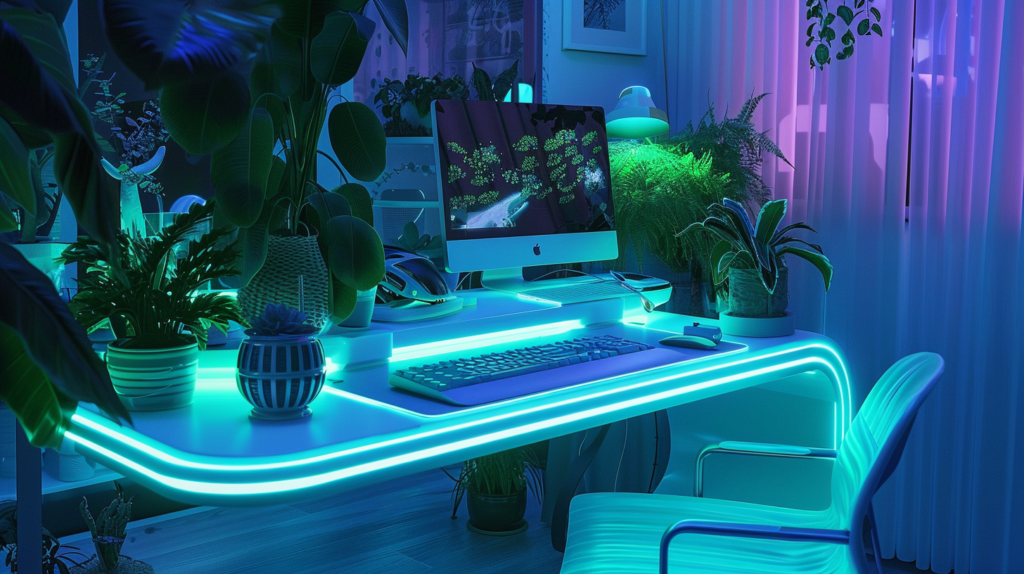
In user experience (UX) design, professionals tirelessly seek innovative ways to enhance human-computer interaction. Enter the concept of intuitive bioluminescent interfaces, a groundbreaking approach that draws inspiration from nature’s design playbook. This natural phenomenon, primarily the domain of deep-sea creatures and a handful of terrestrial organisms, is now illuminating a path toward more intuitive and immersive user experiences through the lens of Bioluminescent UX Design.
For the uninitiated, bioluminescence is nature’s way of saying, “Let there be light,” without relying on the sun. It’s a biochemical emission of light by living organisms, a spectacle that has fascinated humans for centuries. Now, imagine harnessing this natural marvel to create interfaces that not only captivate but also communicate with users in a profoundly organic way through intuitive bioluminescent interfaces. The prospect is not just exciting; it’s a revolutionary step forward in Bioluminescent UX Design.
The application of intuitive bioluminescent interfaces goes beyond mere aesthetic appeal. These interfaces can offer dynamic feedback in real time, adapting to user inputs with visual cues that are as intuitive as they are beautiful. For instance, imagine typing on a keyboard that gently glows with each keystroke, with colors shifting in response to typing speed or the emotional tone of the text. This is Bioluminescent UX Design turned into a multisensory experience, engaging users on a level that traditional interfaces struggle to reach.
Moreover, intuitive bioluminescent interfaces can significantly enhance accessibility. For users with visual impairments, a bioluminescent interface’s subtle glow and color changes can provide cues that are otherwise missed in conventional screen-based interactions. This broadens the user base and underscores the inclusive potential of natural-inspired design within Bioluminescent UX Design.
Sustainability is another compelling aspect of intuitive bioluminescent interfaces. As we grapple with the environmental impact of technology, turning to nature for solutions is both wise and necessary. Bioluminescent materials, being organic, offer an eco-friendly alternative to the electronic displays and LEDs that dominate our gadgets today. Imagine a future where our devices consume significantly less power thanks to the self-illuminating properties of bioluminescent technology within Bioluminescent UX Design.
However, integrating bioluminescence into UX design is not without its challenges. The foremost hurdle is the development of sustainable, long-lasting bioluminescent materials that can be mass-produced. Nature, while generous, does not yield its secrets easily. Extensive research and development efforts are required to translate the ephemeral beauty of bioluminescence into a stable, usable form for intuitive bioluminescent interfaces.
Another challenge lies in the user adoption of intuitive bioluminescent interfaces. As with any radical innovation, convincing users to embrace this new form of interaction within Bioluminescent UX Design requires overcoming skepticism and habituation to traditional interfaces. This means UX designers must not only innovate but educate, demonstrating the tangible benefits of intuitive bioluminescent interfaces in enhancing the user experience.
Despite these challenges, the potential of intuitive bioluminescent interfaces in revolutionizing UX design is undeniable. By bridging the gap between technology and nature, these interfaces promise to redefine our interaction with devices, making it more intuitive, inclusive, and, dare we say, enchanting within the realm of Bioluminescent UX Design.
This shift towards intuitive bioluminescent interfaces requires a collaboration between biologists, chemists, designers, and technologists. It’s a multidisciplinary endeavor that mirrors the complexity and interconnectedness of nature itself within the scope of Bioluminescent UX Design. The journey from concept to reality may be long and fraught with obstacles but the destination—a world where technology feels as natural as the bioluminescence that inspires it—is well worth the effort.
So, as we stand on the brink of this exciting frontier in Bioluminescent UX Design, let’s embrace the challenge with open arms. Integrating bioluminescent technology into user interfaces represents not just a leap forward in design but a return to the natural world that remains our oldest and most innovative teacher.
So, let’s wrap this up with a nod to the luminous creatures that sparked this whole conversation. Just as the firefly lights up the night with its enchanting glow, intuitive bioluminescent interfaces hold the promise to illuminate the future of UX design. It’s a bright future guided by the natural brilliance of the world around us. Let’s move forward, inspired by nature’s genius, to create user experiences that are not only functional and sustainable but also magically intuitive within the innovative sphere of Bioluminescent UX Design. After all, in UX design, sometimes looking back is the best way to leap forward.


